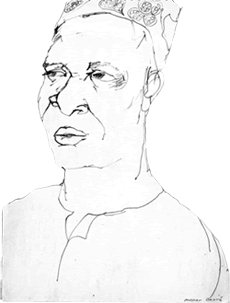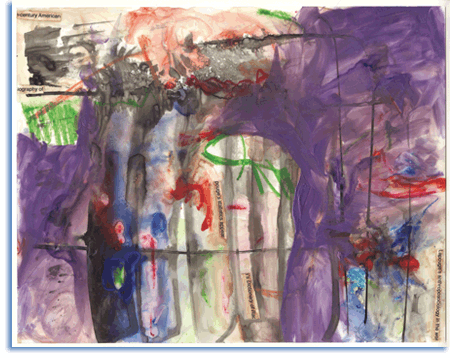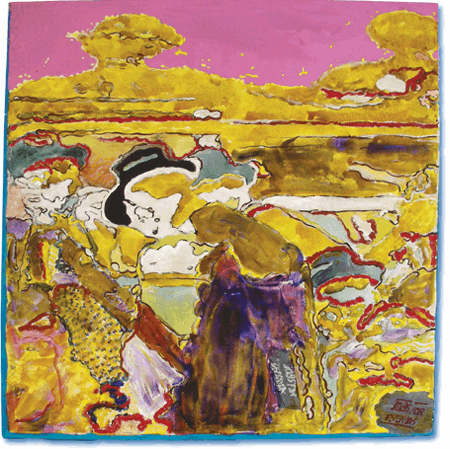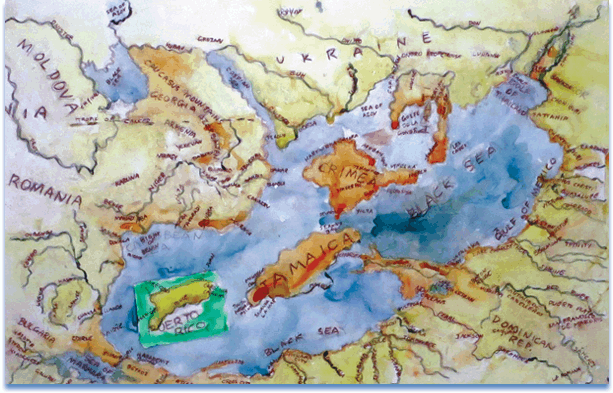Thinking Historically
What’s It Like to Leave Scholarship for Painting?
 Ever since I left history for painting in fall 2006, people have been asking about my experience. My artist's prehistory began with drawing classes at the (then) California College of Arts and Crafts in my hometown of Oakland, California, and a brief stint as an art major at the University of California, Berkeley, where I drew two covers for the campus humor magazine. I also drew in Ghana in the mid-1960s (fig. 1).
Ever since I left history for painting in fall 2006, people have been asking about my experience. My artist's prehistory began with drawing classes at the (then) California College of Arts and Crafts in my hometown of Oakland, California, and a brief stint as an art major at the University of California, Berkeley, where I drew two covers for the campus humor magazine. I also drew in Ghana in the mid-1960s (fig. 1).
I further turned towards the visual in the 1990s with a chapter on Sojourner Truth's photographs in my biography, Sojourner Truth, A Life, A Symbol, and continued with drawing classes in Paris in 2003, introductory painting classes at Princeton in 2003-04, and the New York Studio School's drawing and painting marathon in the summer of 2004, which proved that I could commute from home in Newark to 8th Street in Manhattan and stand up drawing and painting all day, every day, and love it. My last two books, Creating Black Americans: African American History and Its Meanings, 1619 to the Present, whose images are all black fine art, and The History of White People, with four of my drawings on page 26, are both exceedingly visual.I continued my formal art education with a BFA in 2009 from the Mason Gross School of the Arts at Rutgers University and an MFA from the Rhode Island School of Design (RISD) in 2011 (the hardest thing I've ever done in my entire life). Since then I've had a residency at Aferro Gallery, an artist-run space, in Newark, New Jersey; an artist-and-scholar's residency in Yale's Department of African American Studies; and an artist's residency at Yaddo Arts Colony, and I've shown my work in northern New Jersey.
 I also get a lot of questions, which I'll do my best to answer here:
I also get a lot of questions, which I'll do my best to answer here:
Have you always wanted to paint rather than write history? No. I love writing history, just as I love painting. I'm fortunate to have been able to pursue both my loves.
Is painting fun? No, it's too intense to be fun. But it's deeply gratifying, a feast for the eyes. I love the process, and I let the process show in my paintings. My work ranges from figurative, including self-portraits, to abstract (figs. 2 and 3). And my process is digital + manual, which builds on the traces of found imagery (photographs, maps), Adobe Photoshop software, and drawing and painting by hand. I discuss this at length in my RISD MFA thesis, "From Archive to Brush" (e-mail me for a copy).

One example is a series of paintings I did between 2010 and 2012 based on an archive of historical photographs of Brooklyn in the 1970s and 1980s by Lucille Fornasieri-Gold (fig. 4). We will show our work together at Aferro Gallery in Newark in May 2013.
Does your historical knowledge carry over into painting? No, not much, and sometimes it's even regarded as an impediment. Visual meaning and verbal meaning are very different things. My challenge-as a former historian with an interest in narrative themes-is to make visual meaning thoughtfully.
 How do writing history and painting differ? As a historian, I strove to write clearly about complex issues, linking themes logically, one step after another. I took the reader by the hand, and I did the work of conveying meaning.
How do writing history and painting differ? As a historian, I strove to write clearly about complex issues, linking themes logically, one step after another. I took the reader by the hand, and I did the work of conveying meaning.
Painting is more like poetry than scholarship, because juxtaposition rather than tight narrative composes meaning, and meanings need not remain stable. The viewer makes meaning, and above all, the painting must work visually, no matter its sources or its narrative logic. I don't mind at all when viewers see things in my work different from I had in mind as I painted.
For me, one beauty of the visual is its freedom from having to make sense. It's like creating visual fiction, as in the Black Sea Composite maps I made at Yaddo in October 2012 (cover image).
What will you work on next? The historian in me engages archives of images and texts. I also continue to favor historical themes, sometimes using text, which was forbidden me in art school.
My new project, Odalisque Atlas, combines imagery dealing with beauty, sex, and slavery that I discovered in my research for The History of White People and furthered at Yale. In art history the odalisque is a beautiful, young, white slave girl, and the atlas denotes an archive of images. I embed the odalisque in American slavery through texts by those who had been enslaved. This project may result in an artist's book of one or ten copies, or it may become a large piece hanging on the wall.
I don't know when I'll finish it, but my studio affords me ample space to work on more than one piece at a time and in series. Located in the Ironbound section of Newark, my studio is only a four-minute walk from Newark Penn Station. You're welcome to come pay me a studio visit to see how Odalisque Atlas is coming along.
Didn't you publish as Nell Irvin Painter? I distinguish the historian from the painter through a slight word change. Nell Painter is the painter, Nell Irvin Painter is the historian.-Nell Painter can be reached at painter@princeton.edu. For more on her work, both historical and artistic, visit www.nellpainter.com and her Facebook page.

Tags: Career Diversity for Historians Resources for Early Career
Comment
Please read our commenting and letters policy before submitting.






